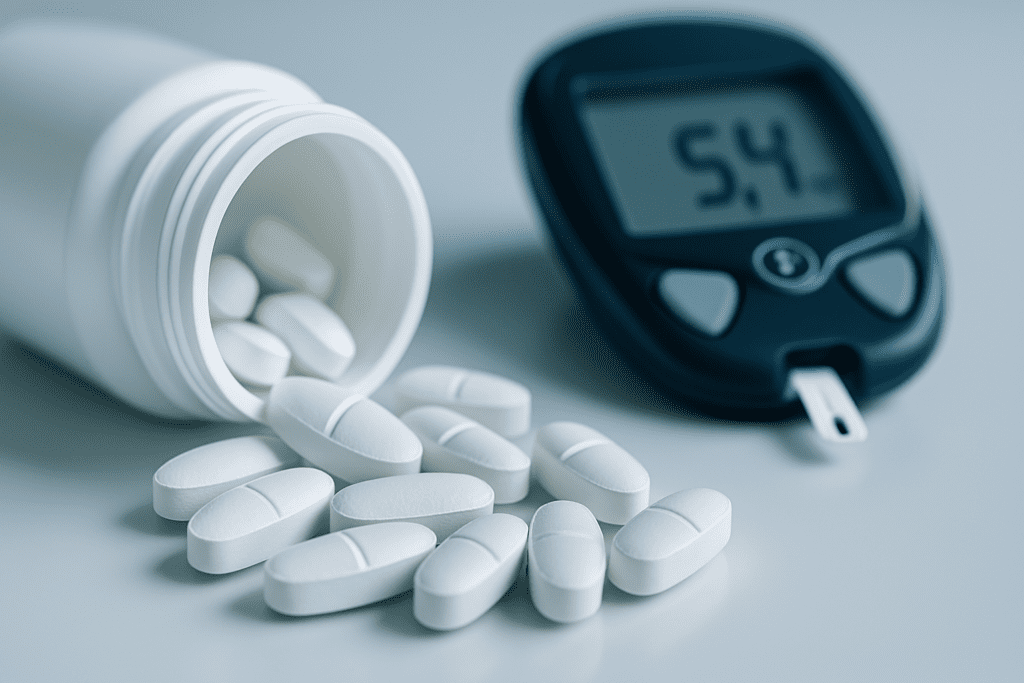Understanding the Need for Hypoglycemic Oral Medications
In recent decades, the global burden of diabetes has surged, prompting a need for more effective therapeutic strategies. While insulin therapy remains a cornerstone in diabetes management, especially for those with type 1 diabetes, oral antidiabetic drugs have emerged as critical tools in the treatment of type 2 diabetes. As researchers and clinicians seek solutions that optimize glycemic control with minimal side effects, hypoglycemic oral medications have gained increased attention. These low blood sugar meds work by targeting different pathways involved in glucose metabolism, offering a broader range of mechanisms and more individualized approaches to managing hyperglycemia.
You may also like: Breakthroughs in Current Diabetes Research: What the Latest Studies Reveal About Treatment and Prevention
The increasing prevalence of type 2 diabetes is not only a clinical challenge but also a public health crisis. According to the World Health Organization, over 400 million people globally live with diabetes, and the vast majority of these cases are type 2. This has led to a surge in pharmaceutical innovation, with a focus on developing oral medication for hypoglycemia that can safely and effectively lower blood glucose without causing undue hypoglycemic events. As the science behind these drugs evolves, so too does our understanding of their benefits, limitations, and long-term impact on metabolic health.
Defining Hypoglycemic Oral Medications and Their Mechanisms
To grasp the significance of recent breakthroughs, it is essential to begin by answering the question: what are hypoglycemic medications? These drugs are designed to reduce blood glucose levels, primarily in individuals with type 2 diabetes. Unlike insulin injections, which directly supply the body with insulin, hypoglycemic oral medications either stimulate the pancreas to produce more insulin, reduce the liver’s glucose output, or enhance insulin sensitivity in peripheral tissues.
Different classes of oral antidiabetic drugs fall under this umbrella. Sulfonylureas, for example, stimulate pancreatic beta cells to release more insulin. Biguanides, such as metformin, decrease hepatic glucose production and improve insulin sensitivity. Thiazolidinediones target insulin resistance through their effects on nuclear receptors that influence gene expression. Other classes, like DPP-4 inhibitors and SGLT2 inhibitors, provide additional mechanisms—such as prolonging incretin hormone activity or increasing glucose excretion through the urine.
The diversity among these drug classes reflects the complexity of diabetes itself. Not every patient responds equally to every therapy, and this has led to the rise of personalized medicine approaches within endocrinology. Understanding how low blood sugar meds work at the molecular level is thus not only academically interesting but clinically imperative, guiding tailored treatment strategies that maximize efficacy and minimize risks.

The Evolution of Oral Antidiabetic Drugs: From First-Generation to Next-Gen Therapies
The history of oral antidiabetic drugs dates back to the mid-20th century with the discovery of sulfonylureas, which were the first widely adopted hypoglycemic oral medications. While effective, these drugs are associated with a significant risk of hypoglycemia and weight gain, making them less ideal for long-term use in many patients. Over time, pharmaceutical research has aimed to develop safer, more targeted therapies with fewer side effects.
Biguanides, particularly metformin, quickly became the gold standard due to their efficacy and favorable safety profile. Metformin is now the first-line oral medication for hypoglycemia in type 2 diabetes and remains one of the most widely prescribed drugs globally. However, even metformin has its limitations, particularly in patients with renal impairment or gastrointestinal sensitivity.
In the last two decades, the emergence of novel drug classes has reshaped the therapeutic landscape. DPP-4 inhibitors, which increase the body’s own insulin production by extending the activity of incretin hormones, provide a more physiologic and glucose-dependent approach to lowering blood sugar. Similarly, SGLT2 inhibitors help eliminate excess glucose through the kidneys, offering not only glycemic control but also cardiovascular and renal benefits.
These advancements reflect a paradigm shift from merely managing blood glucose to targeting broader aspects of metabolic and systemic health. Today’s low blood sugar meds are not just about glycemic reduction—they also aim to reduce cardiovascular risk, support kidney function, and improve quality of life. This comprehensive approach marks a significant advancement over the narrower objectives of earlier generations.
The Role of Personalized Medicine in Hypoglycemic Drug Therapy
Personalized medicine has become a central theme in modern healthcare, and its application in diabetes treatment is particularly compelling. Given the heterogeneity in pathophysiology, genetics, and lifestyle among patients with type 2 diabetes, a one-size-fits-all approach to oral antidiabetic drugs is no longer tenable. Advances in genomic medicine, biomarkers, and digital health tools are allowing clinicians to select the most appropriate hypoglycemic oral medications based on individual profiles.
For example, genetic variations in drug-metabolizing enzymes can affect how a person responds to sulfonylureas or metformin. Similarly, the presence of comorbidities such as cardiovascular disease or chronic kidney disease may influence the selection of SGLT2 inhibitors or GLP-1 receptor agonists. Even patient preferences and tolerability must be factored into the equation, highlighting the multidimensional nature of treatment planning.
Digital health innovations, such as continuous glucose monitoring and artificial intelligence-driven decision support tools, are further enabling the customization of therapy. These tools not only track glycemic patterns but also help predict adverse events, optimize drug dosing, and facilitate proactive adjustments. The growing integration of technology in diabetes management underscores the potential of a more refined and responsive therapeutic framework.
As our understanding of what are hypoglycemic medications continues to evolve, so too does the capacity to match the right drug to the right patient at the right time. This shift toward personalization holds the promise of better outcomes, reduced complications, and improved adherence—core goals in the battle against chronic disease.
Risks and Challenges Associated with Low Blood Sugar Meds
Despite their many benefits, hypoglycemic oral medications are not without their risks. One of the most significant concerns remains the potential for hypoglycemia—a condition characterized by abnormally low blood sugar levels that can lead to dizziness, confusion, loss of consciousness, and even seizures if untreated. While modern drugs tend to pose less risk than their predecessors, the danger is not entirely eliminated.
Sulfonylureas, for instance, are well-known for their hypoglycemic potential, especially in older adults or those with inconsistent eating habits. Even newer medications, when used in combination or with insulin, may amplify the risk of adverse glycemic events. Clinicians must therefore carefully assess each patient’s risk profile when prescribing oral medication for hypoglycemia, balancing effectiveness against safety.
Drug interactions also pose a challenge, particularly in patients managing multiple chronic conditions. Some hypoglycemic oral medications can interact with antibiotics, diuretics, or cardiovascular drugs, altering their metabolism and effectiveness. Moreover, gastrointestinal side effects—such as nausea, bloating, and diarrhea—can compromise medication adherence and overall treatment success.
Monitoring and patient education are essential in mitigating these risks. Teaching patients how to recognize symptoms of hypoglycemia, encouraging regular blood glucose monitoring, and emphasizing the importance of consistent food intake all contribute to safer use. As such, the safe administration of oral antidiabetic drugs is as much about patient empowerment as it is about pharmacology.

Clinical Innovations and Ongoing Research in Hypoglycemic Therapy
The field of hypoglycemic drug therapy is currently experiencing a renaissance, with numerous innovations pushing the boundaries of what’s possible. Researchers are investigating dual-action compounds that combine the benefits of multiple drug classes into a single pill. These agents aim to improve adherence and simplify regimens while offering synergistic effects on glucose control.
One area of intense focus is the development of oral formulations for GLP-1 receptor agonists, which have traditionally been injectable. Early studies suggest that these orally available agents may provide comparable efficacy, ushering in a new era of convenience for patients who prefer not to use injections. At the same time, novel biomarkers are being explored to predict individual responses to therapy, enabling even more refined personalization.
Advanced drug delivery systems, such as sustained-release tablets and nanotechnology-based carriers, are also on the horizon. These systems aim to optimize drug absorption, minimize gastrointestinal side effects, and provide more stable pharmacokinetics. When combined with digital monitoring tools, they offer a glimpse into the future of fully integrated diabetes care.
In parallel, large-scale clinical trials continue to explore the long-term effects of various hypoglycemic oral medications on cardiovascular outcomes, renal function, and even cognitive health. These studies will help determine which medications offer the most comprehensive benefits and inform guidelines that shape global clinical practice.
Societal and Economic Implications of Oral Antidiabetic Drugs
The widespread adoption of oral antidiabetic drugs has significant implications not only for individual health but also for healthcare systems and economies at large. As type 2 diabetes becomes more prevalent, the demand for effective, affordable, and accessible medications has never been higher. Fortunately, the growing availability of generic versions of common hypoglycemic oral medications has helped reduce costs, making treatment more attainable for patients worldwide.
However, disparities persist. In low- and middle-income countries, access to essential medications remains uneven, limiting the benefits of scientific progress. Moreover, the rising cost of newer drugs—particularly those still under patent protection—continues to strain healthcare budgets. This has sparked debates over pricing, reimbursement policies, and the ethical responsibility of pharmaceutical companies.
At the same time, the economic benefits of effective glucose control cannot be overstated. By reducing the risk of complications such as neuropathy, retinopathy, cardiovascular events, and kidney failure, low blood sugar meds can significantly decrease long-term healthcare expenditures. From a public health perspective, investment in effective oral medication for hypoglycemia represents not just clinical good sense, but economic prudence.
As societies grapple with the dual challenges of chronic disease and healthcare sustainability, the value of cost-effective, evidence-based pharmacotherapy becomes increasingly clear. Ensuring equitable access to these therapies will be a key determinant of future health outcomes on a global scale.

Frequently Asked Questions: Hypoglycemic Oral Medications and Low Blood Sugar Treatments
1. Can hypoglycemic oral medications help prevent diabetes complications beyond blood sugar control?
Yes, emerging evidence shows that some hypoglycemic oral medications offer benefits that extend far beyond simply lowering blood sugar. Certain oral antidiabetic drugs, such as SGLT2 inhibitors and GLP-1 receptor agonists, have demonstrated protective effects on the heart and kidneys in individuals with type 2 diabetes. These low blood sugar meds help reduce the risk of cardiovascular events, including heart attacks and strokes, which are among the leading causes of mortality in this population. Additionally, newer drugs may help with weight management and inflammation control, both of which are critical in mitigating long-term complications. As research progresses, the broader therapeutic potential of these agents continues to reshape our understanding of what are hypoglycemic medications truly capable of.
2. How do lifestyle factors impact the effectiveness of oral medication for hypoglycemia?
Lifestyle factors play a pivotal role in the success of oral medication for hypoglycemia. Diet, physical activity, stress levels, and sleep quality all directly influence insulin sensitivity and glucose metabolism, which in turn affect how well oral antidiabetic drugs perform. For instance, a nutrient-rich, balanced diet can enhance the effect of metformin or DPP-4 inhibitors, while a sedentary lifestyle may blunt their efficacy. Alcohol intake and erratic meal timing can increase the risk of hypoglycemia, especially when combined with certain low blood sugar meds like sulfonylureas. Long-term adherence to hypoglycemic oral medications improves significantly when lifestyle choices align with therapeutic goals, reinforcing the need for holistic care.
3. Are there any psychological or emotional impacts associated with taking oral antidiabetic drugs?
Absolutely. Managing a chronic condition like diabetes can carry significant psychological burdens, and the initiation of oral antidiabetic drugs often comes with mixed emotions. Some patients report feelings of failure or fear upon starting medication, particularly when they had hoped to control their condition through lifestyle alone. Over time, anxieties about side effects, dependency, or long-term efficacy may arise, especially with complex regimens or when using multiple low blood sugar meds. Healthcare providers can help alleviate these concerns by providing education, reassurance, and involving patients in shared decision-making. When patients feel informed and empowered, they are more likely to view hypoglycemic oral medications as supportive tools rather than symbols of disease progression.
4. How do clinicians determine the best hypoglycemic oral medication for an individual patient?
The process of selecting the most appropriate hypoglycemic oral medication is multifactorial and highly personalized. Clinicians consider numerous variables, including age, comorbidities, current kidney or liver function, lifestyle, and even socioeconomic status. For example, a patient with heart disease may benefit more from SGLT2 inhibitors, while someone with gastrointestinal sensitivity might tolerate DPP-4 inhibitors better than metformin. Cost and accessibility also influence decisions, particularly in regions with limited insurance coverage for newer oral antidiabetic drugs. Advances in pharmacogenomics are beginning to inform these choices even further, suggesting that in the future, genetic profiling may become a standard tool for matching patients with the most effective low blood sugar meds.
5. Are there any misconceptions about what are hypoglycemic medications that people should be aware of?
Yes, several misconceptions still persist regarding what are hypoglycemic medications and how they function. One common myth is that all oral antidiabetic drugs work the same way or are interchangeable, which can lead to poor adherence or mismanagement. Another is that oral medication for hypoglycemia can replace healthy lifestyle habits, which is rarely the case—medications are most effective when paired with proper diet and exercise. Some also mistakenly believe that hypoglycemic oral medications are only needed in advanced stages of diabetes, when in fact, early use can help preserve pancreatic function and delay disease progression. Dispelling these myths through patient education is critical for optimizing outcomes and preventing treatment burnout.
6. How is research changing the future of oral antidiabetic drugs?
Research is rapidly transforming the landscape of oral antidiabetic drugs, especially as technology intersects with pharmacology. Scientists are now exploring dual or triple combination therapies that target multiple pathways simultaneously, potentially reducing pill burden and improving adherence. Drug delivery innovations, such as nanoparticle formulations, may enhance the absorption and stability of hypoglycemic oral medications, reducing side effects and maximizing therapeutic impact. Additionally, artificial intelligence is being used to analyze patient data and recommend personalized drug combinations based on predictive modeling. These innovations may redefine not only how we use low blood sugar meds but also how we integrate them into digital, continuous care models. The next decade is likely to see a dramatic shift toward precision medicine in this domain.
7. What should patients know about safely transitioning between different classes of low blood sugar meds?
Switching between different classes of low blood sugar meds should be done cautiously and under the supervision of a healthcare provider. Factors such as drug half-life, potential for overlapping effects, and the risk of hypoglycemia must all be evaluated during transitions. For example, moving from a sulfonylurea to an SGLT2 inhibitor involves a shift in mechanism that may require temporary glucose monitoring to avoid dips or spikes. Patients also need to be educated on new side effects and interactions, especially when combining oral antidiabetic drugs with insulin or other agents. Coordinated care involving pharmacists, diabetes educators, and clinicians can greatly enhance the safety and success of such transitions, emphasizing that oral medication for hypoglycemia is not a static treatment but a dynamic process.
8. Can hypoglycemic oral medications be used for non-diabetic conditions?
Interestingly, researchers are exploring the use of hypoglycemic oral medications beyond diabetes. For example, metformin is being studied for its potential anti-aging, anti-cancer, and fertility-enhancing effects. In women with polycystic ovary syndrome (PCOS), metformin has been used to improve insulin resistance and restore ovulation. Some SGLT2 inhibitors are being investigated for their cardiovascular and renal benefits in non-diabetic populations, suggesting their utility may extend to heart failure and chronic kidney disease management. While these applications remain off-label or under investigation, they highlight the broader pharmacologic potential of oral antidiabetic drugs. However, such use should only occur within a research or specialist-guided context to ensure safety and efficacy.
9. How do hypoglycemic oral medications interact with dietary supplements or herbal remedies?
Interactions between hypoglycemic oral medications and dietary supplements or herbal remedies are an important yet often overlooked issue. Certain supplements, such as chromium, berberine, and bitter melon, are known to have glucose-lowering effects and can amplify the action of low blood sugar meds, potentially increasing the risk of hypoglycemia. Meanwhile, others like St. John’s Wort may interfere with drug metabolism, affecting the plasma levels of oral antidiabetic drugs. Patients often do not disclose supplement use unless specifically asked, making it crucial for providers to inquire proactively. Integrative approaches can be beneficial but must be carefully coordinated to avoid unintended interactions, especially when using multiple hypoglycemic oral medications concurrently.
10. What role does patient education play in the long-term success of oral medication for hypoglycemia?
Patient education is arguably one of the most influential factors in the long-term success of oral medication for hypoglycemia. Understanding how and when to take medications, recognizing early signs of hypoglycemia, and knowing what to do in emergencies can dramatically reduce adverse outcomes. Education also promotes adherence by demystifying side effects and helping patients set realistic expectations about results. Empowered patients are more likely to engage in proactive health behaviors and collaborate effectively with their healthcare team. As the therapeutic options for low blood sugar meds expand, tailored education that addresses the nuances of various oral antidiabetic drugs becomes increasingly vital for ensuring safe and effective disease management.
Conclusion: The Future of Hypoglycemic Oral Medications in Diabetes Care
In an era marked by both unprecedented scientific innovation and mounting public health challenges, the emergence of advanced hypoglycemic oral medications offers a promising beacon of hope. These therapies, ranging from time-tested agents like metformin to cutting-edge dual-action compounds and oral GLP-1 receptor agonists, are reshaping how we approach diabetes care. No longer confined to the singular goal of lowering blood glucose, today’s low blood sugar meds serve a broader mission—improving cardiovascular health, protecting renal function, and enhancing quality of life.
Yet as the field evolves, so too must our approach to treatment. Understanding what are hypoglycemic medications is only the beginning. Clinicians, researchers, and patients alike must stay informed about the expanding landscape of oral antidiabetic drugs and engage in shared decision-making to personalize therapy. With ongoing research, digital health integration, and a growing emphasis on patient-centered care, the future of diabetes management holds the potential for even greater precision, safety, and efficacy.
Ultimately, the success of hypoglycemic oral medications will depend not only on their pharmacological merit but on how well they are integrated into the lives and healthcare systems of those who need them. By investing in education, equity, and innovation, we can ensure that the promise of these medications is fully realized—delivering better outcomes for individuals and populations alike.
glucose lowering therapies, type 2 diabetes treatment options, insulin resistance management, diabetes drug development, blood glucose control strategies, innovative diabetes treatments, diabetic kidney protection, cardiovascular benefits of diabetes drugs, personalized diabetes care, precision medicine in endocrinology, combination diabetes therapies, oral glucose control agents, diabetic medication adherence, continuous glucose monitoring insights, digital tools for diabetes, managing hypoglycemia risks, metabolic health optimization, long-term diabetes management, chronic disease pharmacotherapy, diabetic comorbidity management
Further Reading:
Diabetes-related hypoglycemia, contributing risk factors, glucagon prescriptions in two community hospitals
Your guide to understanding Hypoglycemia (low blood sugar)
New Hypoglycemic Drugs: Combination Drugs and Targets Discovery
Disclaimer
The information contained in this article is provided for general informational purposes only and is not intended to serve as medical, legal, or professional advice. While MedNewsPedia strives to present accurate, up-to-date, and reliable content, no warranty or guarantee, expressed or implied, is made regarding the completeness, accuracy, or adequacy of the information provided. Readers are strongly advised to seek the guidance of a qualified healthcare provider or other relevant professionals before acting on any information contained in this article. MedNewsPedia, its authors, editors, and contributors expressly disclaim any liability for any damages, losses, or consequences arising directly or indirectly from the use, interpretation, or reliance on any information presented herein. The views and opinions expressed in this article are those of the author(s) and do not necessarily reflect the official policies or positions of MedNewsPedia.


